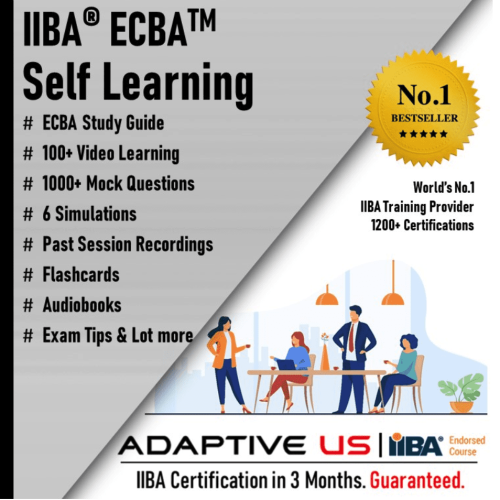Underlying Competencies of Business Analysis
The dynamic and ever-changing world of business analysis dictates that the professionals in this area must possess a wide area of fundamental competencies required for the work they are expected to do. The underlying competencies that make a good business analyst include various knowledge areas, behaviours, characteristics, and personal qualities. One should see these basic skills only as a foundation for further improvement and building a proficiency that will enable the business analyst to massively contribute to the success of the organisation and accomplish the set goals.
The IIBA has a business analysis competency model 
The BABOK
The 6 underlying competencies areas are:
- Analytical Thinking and Problem Solving
- Behavioural Characteristics
- Business Knowledge
- Communication Skills
- Interaction Skills
- Tools and Technology
The 6 underlying competencies meanings are further described below.
Table of Contents
Analytical Thinking and Problem Solving
To be able to properly identify problems and opportunities and determine, along with the stakeholders, which changes provide maximum value, the business analyst must be adept at analytical thinking and problem solving.
During the project, the analyst will encounter an enormous amount of information including stakeholders’ needs and concerns, customer feedback, various standards implemented ant an organisation. The ability to think analytically will enable them to assimilate all this information and distinguish relevant from irrelevant.
Creative Thinking
Creative implies the ability of the business analyst to generate new concepts and ideas and find new ways to link the existing ones or discover better alternatives. Often the analysis requires looking at the stakeholders’ needs from a different angle and suggesting new approaches.
Decision Making
Decision making is employed when the business analyst needs to choose between various alternatives and has to decide which one will bring the most value to the organisation and stakeholders.
The decision may include the choice of a suitable technique for a certain task, which stakeholders to approach for assistance, which solution is the most effective, and so on. This competency involves a profound understanding of the decision making criteria and the ability to help others to make better decisions.
Learning
The career of a business analyst involves constant self-improvement and expanding the set of skills and knowledge. Quickly absorbing and understanding new information and applying the existing knowledge to the task at hand is crucial for successful analysis performance.
The goal of learning about the new business domain is to gain a full understanding of the process to be able to apply the acquired knowledge to create and implement the best solutions. Learning techniques can be visual, auditory, or kinesthetics.
Problem Solving
Encountering the problems is a part of every stage of the business analysis process. Problem solving skills
Systems Thinking
Understanding how technology, processes, and people interact with each other in the context of the whole organisation is a basis of systems thinking. It enables a holistic approach to business analysis and enables the analyst to understand the processes that can not be comprehended if observed individually.
Conceptual Thinking
The skills of conceptual thinking help the business analyst establish links between solutions, needs, values, stakeholders, and changes in an organisational context. The big picture obtained this way allows for an understanding of the place of every new information and detail in the organisation as a whole.
Visual Thinking
For a solution to be approved and implemented, it firs needs to be well understood by all of the involved stakeholders. Visual thinking is the ability of the business analyst to communicate the complex information and concepts in a way that is easily understood and allows for easier engagement of stakeholders. This is done by creating visual representations such as diagrams, graphics, or models.
Behavioural Characteristics
Behavioural characteristics are important for increasing the personal effectiveness of a business analyst and can decidedly influence the output of the analysis project. These characteristics include skills and behaviours that allow the analyst to perform a better job by gaining respect and developing good relationships with stakeholders. Behavioural characteristics involve five key underlying competencies.
Ethics
The key to earning the respect of the stakeholders and also members of the team is ethical behaviour. The business analyst holds a key position in the project and has access to most of the organisation’s vital and sensitive information so their ethics are extremely important to the stakeholders. The analyst must be able to identify ethical dilemmas with a certain solution and help reduce organisational exposure to such risk.
Personal Accountability
Personal accountability of the business analyst ensures that the undertaken tasks will be completed on time, align with the overall business needs and that the set goals are met. It helps the analyst establish credibility within the organisation. Personally accountable business analyst performs their task thoroughly, plans the activities per the needs, chase all the leads, and ties up all of the loose ends.
Trustworthiness
The business analysis activities often deal with the most valuable and sensitive assets and processes of an organisation, and sometimes can jeopardise the whole business. The business analysts can not perform their tasks and elicit information without the trust of the stakeholders. They need to be convinced that the analyst will perform the job thoroughly, confidently if needed and that the proposed actions are carefully thought through and evaluated.
Organisation and Time Management
Organisation and time management implies the ability of a business analyst to prioritise and effectively perform tasks and efficiently use the work time. During the project, a lot of activities are time-sensitive, and managing them effectively will significantly contribute to efficient solutions. This skill also involves adequate acquiring and organising information and recording and storing it in a way that is suitable for further use.
Adaptability
Business analysis is characterised by working in dynamic environments and with a variety of stakeholders. the business analyst needs to be able to adjust to these ever-changing settings and adjust their techniques, tools, and methods accordingly. By doing this, the analyst ensures that the interaction with stakeholders and task performance is always effective and productive.
Business Knowledge
The key competency of a business analyst and the one without which the high-level performance wouldn’t be possible is business knowledge. It provides an understanding of the structure, needs, and underlying processes of an organisation. To develop the highest value solution, the business analyst must have a full understanding of business principles and practices. This knowledge is gained through past experience and constant learning and improvement.
Business Acumen
Knowledge of how other organisations function and solve their problems creates then business acumen that can be used for any future project. Enterprises, especially those in the same industry, often share practices concerning sales, marketing, logistics, and any other business aspect. When developing a new solution, the business analyst can always draw on their knowledge of how a similar need was satisfied in a similar organisation.

Industry Knowledge
When working in an organisation, the business analyst must possess the knowledge of the practices and activities within the industry that the organisation belongs to. This knowledge can help better understand the competition in the field, trends, services, regulations, and all of the other aspects within the given field. Also, it provides the analyst with an awareness of the place a particular organisation holds within its industry and market.
Organisation Knowledge
Organisational knowledge helps the analyst understand the management and business structure of an organisation. It includes the knowledge of relationships between departments and stakeholders, how the organisation profits and accomplish its goals, communication channels, decision making.
Solution Knowledge
The solution knowledge helps analysts implement the knowledge of the organisation to develop the most efficient solutions. While working on a solution, the BAs often reuse the knowledge gained in previous similar processes. This speeds up elicitation and analysis needed for devising a new solution.
Methodology Knowledge
The knowledge of methodology helps the analyst determine the timeline of activities and identify the right approach, stakeholders’ roles, and potential risks. It also increases the ability to adapt and answer any changes in the environment, new needs, and potential changes.
Communication Skills
The project can hardly be successful without the proper communication between everyone involved. the communication can be verbal, non-verbal, physical, or written. When successful, communication provides all of the sides involved an equal level of understanding the matter communicated. Various processes and stakeholders may require different forms of communication, so the business analyst must be able to adapt and adjust the communication style to the recipients. Communication skills involve four core competencies.
Verbal Communication
The verbal communication implies the ability of a business analyst to verbally express to stakeholders their ideas, opinions, concepts, and information. A good part of communication during the project is done verbally during the informal sessions, workshops, or brainstorming. The spoken words must provide a clear understanding of the matter to the recipient. Verbal heavily relies on the sender’s style and tone, and it can influence the way the recipient absorbs the information and thus impact the result of the communication.
Non-Verbal Communication
The skills of non-verbal communication involve the ability to convey the message using mean other than verbal. This includes body movement, gestures, facial expression, or eye contact. Non-verbal communication can significantly add to the meaning of the message communicated. when mastered, it can also present the business analyst as a trustworthy and confident person. Also, it helps discover if the stakeholders’ attitude towards a certain matter is not aligned with their verbal message.
Written Communication
In the course of the project the ideas, concepts, and opinions are often communicated in written form. Mastering the written communication ensures that these messages are well and properly understood. The understanding often depends on the recipient, so the written communication should be adjusted accordingly. To do this, the business analyst must have a broad vocabulary, understanding which terms are appropriate for certain recipients, and a full grasp of grammar and style.
Listening
The business analysts are often on the receiving end of communication and to understand what is being said to them they must learn to understand the meaning of the conveyed message in a context. Also, active listening involves being able to discern the important aspects of communication from irrelevant.
Interaction Skills
To be able to relate, communicate, and collaborate with various stakeholders involved in a project, the business analyst must master the interaction skills. They are often required to facilitate communication and help understanding certain aspects of a project and that can not be done without the satisfying ability to interact. Interaction skills include five key competencies.
Facilitation
Being able to facilitate interaction helps the analysts assist the stakeholders in decision making, problem-solving, and exchanging ideas and opinions. Properly facilitated discussion ensures that all of the participants have a chance to clearly articulate the reviews and understand the opinion and points of view of others.
Leadership and Influencing
No matter if the people are formally reporting to business analysts, leadership and influencing skill are necessary for guiding stakeholders through the processes during the project. The business analyst is responsible for motivating people to work towards the common goal and for defining and communicating the business analysis information so the stakeholders can have a clear vision of the desired future state of the organisation.
Teamwork
Successful development and implementation of the solution requires joint, synchronised, and productive efforts of various team members, stakeholders, and other sides invested in the process. Often, the relationship with these people can make or break the project so it’s crucial that the business analyst has the understanding and skills to form the right team and enable it to function effectively.
Negotiation and Conflict Resolution
As the project moves on, the business analysts are often required to mediate negotiation between stakeholders or to take part in negotiation themselves. The goal of mediating negotiations is to ensure that the interested sides realise that there are differing views and to help them reach an agreement to the mutual benefit. The business analyst also needs to make sure that the outcome of the negotiation is aligned with the desired solutions.
Teaching
The possession of teaching skill enables business analysts to better communicate their ideas, concepts, requirements, and issues and to ensure their understanding by the stakeholders. The analysts need to be a good teacher and lead others in gaining knowledge while understanding the different learning capabilities of individuals. They need to select the most appropriate teaching approaches according to the material being taught.
Tools and Technology
While working on a project the project, the business analyst is usually required to use a wide range of software applications, word processing tools, or management technologies. Proficiency in the use of these tools and technologies enables better communication, requirements maintenance, issue tracking, and solution development. The Tools and Technology skillset includes three core competencies.
Office Productivity Tools and Technology
Office productivity tools and technology are used to track, manage, record, and store information and artefacts. They provide a better understanding and insight into available information. Getting familiar with these applications opens avenues to more efficient performance and eases the use of similar technologies.
Business Analysis Tools and Technology
The outputs the business analyst provides for stakeholders, including analysis activities and deliverables, are modelled, documented, and measured by a wide range of tools and technology. These tools provide capabilities in modelling, diagramming, documenting, analysing requirements., identifying their relationships, and stakeholder communication.
Communication Tools and Technology
Communication tools can be used while performing a variety of business analysis tasks including team management, stakeholder communication, and collaborative task planning. Proficient use of these tools provides better communication and understanding which leads to more efficient decision making. Communication and collaborative tools include voice communication, instant messaging, e-mailing, video conferencing, electronic calendars, and online brainstorming tools.
Conclusion – Underlying Competencies of Business Analyst
The underlying competencies BABOK defines 6 key groups of underlying competencies that a business analyst is expected to possess.
What are the underlying competencies? The underlying competencies areas are:
- Analytical Thinking and Problem Solving
- Behavioural Characteristics
- Business Knowledge
- Communication Skills
- Interaction Skills
- Tools and Technology
The underlying competencies for business analysts are competencies that every business analyst is required to demonstrate in their job. Business analyst should seek to review, assess and improve on their underlying competencies





